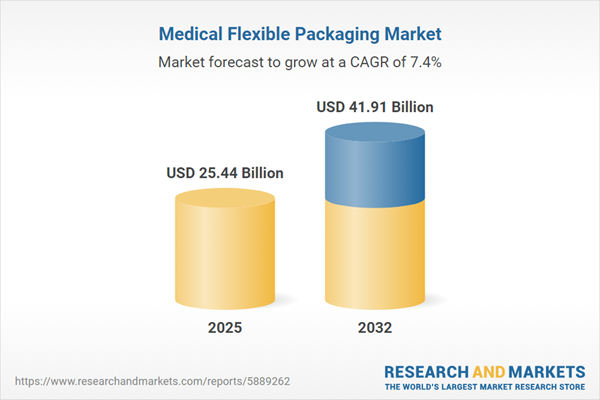Speak directly to the analyst to clarify any post sales queries you may have.
The medical flexible packaging market is experiencing rapid transformation, driven by material innovation, technology adoption, and evolving healthcare requirements. Senior decision-makers must understand the impact of these changes to craft responsive strategies and capture new business value.
Market Snapshot: Medical Flexible Packaging Market Growth at a Glance
The Medical Flexible Packaging Market grew from USD 23.69 billion in 2024 to USD 25.44 billion in 2025. It is expected to continue growing at a CAGR of 7.39%, reaching USD 41.91 billion by 2032. This growth reflects the sector’s transition as manufacturers, healthcare providers, and supply chain stakeholders respond to intensifying safety demands, sustainability goals, and the proliferation of personalized medicine. Advanced barrier solutions, digital features, and form factor diversity are now at the forefront of procurement and design strategies across the value chain.
Scope & Segmentation
- Material Types: Composite films (paper-plastic composite, plastic-aluminum composite), foil (aluminum foil, composite foil), paper, and plastic (polyethylene, polyethylene terephthalate, polypropylene)
- Packaging Forms: Bags (gusseted and tube bags), blisters (cold-formed and thermoformed), films (roll and sheet), pouches (flat and stand-up), and sachets (multi-chamber, single-chamber)
- End Users: Clinics (general and specialty), hospitals (private and public), pharmaceutical companies, research centers (academic and industrial R&D)
- Geographic Regions: Americas (North America: United States, Canada, Mexico; Latin America: Brazil, Argentina, Chile, Colombia, Peru), Europe, Middle East & Africa (Europe: United Kingdom, Germany, France, Russia, Italy, Spain, Netherlands, Sweden, Poland, Switzerland; Middle East: United Arab Emirates, Saudi Arabia, Qatar, Turkey, Israel; Africa: South Africa, Nigeria, Egypt, Kenya), Asia-Pacific (China, India, Japan, Australia, South Korea, Indonesia, Thailand, Malaysia, Singapore, Taiwan)
- Technologies: Advanced barrier films, digital printing, smart packaging, automation, serialization, recyclable and biodegradable materials, cold chain solutions, and integrated production analytics
- Industry Players: Amcor plc, Berry Global Inc., Sealed Air Corporation, Huhtamaki Oyj, Sonoco Products Company, Winpak Ltd., Essentra plc, Mondi plc, Ahlstrom-Munksjö Oyj, Mitsubishi Chemical Group Corporation
Key Takeaways: Strategic Insights for Decision-Makers
- Material breakthroughs and barrier technology innovation are fundamental to meeting evolving safety, cost, and sustainability requirements in healthcare packaging.
- Digital printing, serialization, and smart sensors support real-time monitoring, traceability, and label customization for pharmaceutical and clinical applications.
- Emerging biodegradable polymers and sustainable composite solutions are rapidly reshaping value propositions, especially as regulatory oversight becomes more rigorous globally.
- Regional market dynamics differ: the Americas prioritize regulatory compliance and sustainability, EMEA emphasizes production efficiency, and Asia-Pacific is experiencing healthcare infrastructure expansion and regulatory harmonization.
- Providers are investing in automation, nearshore manufacturing, and integrated quality systems to enhance supply chain resilience and respond to changing input costs.
- Partnerships among materials scientists, OEMs, and logistics providers are unlocking new solutions for cold chain integrity and customized packaging forms.
Assessing the Tariff Impact in 2025: Supply Chain and Cost Structure Evolution
The introduction of new United States tariffs in 2025 on select resins, aluminum foils, and barrier films imposed direct cost pressures on manufacturers. In response, many have rebalanced sourcing, increased nearshore production, and sought strategic partnerships with upstream suppliers to control input expenses. These shifts have accelerated the search for alternative materials and prompted innovation in local sourcing strategies and production footprint adjustments.
Methodology & Data Sources
This analysis is based on comprehensive interviews with industry professionals, reviews of technical literature, regulatory documents, and trade data. Data triangulation and expert peer review ensure all insights are robust, current, and actionable for leaders in medical flexible packaging.
Why This Report Matters
- Empowers leadership teams to optimize procurement, R&D, and manufacturing choices in a complex, evolving regulatory environment.
- Enables informed decisions on strategic investments by highlighting the interplay between technology adoption, regional market requirements, and competitive shifts.
Conclusion
Understanding the evolving material landscape, regulatory climate, and regional trends is essential for sustained performance in medical flexible packaging. This report equips stakeholders with the insight required to drive competitive advantage and operational success.
Additional Product Information:
- Purchase of this report includes 1 year online access with quarterly updates.
- This report can be updated on request. Please contact our Customer Experience team using the Ask a Question widget on our website.
Table of Contents
3. Executive Summary
4. Market Overview
7. Cumulative Impact of Artificial Intelligence 2025
Companies Mentioned
The companies profiled in this Medical Flexible Packaging market report include:- Amcor plc
- Berry Global Inc.
- Sealed Air Corporation
- Huhtamaki Oyj
- Sonoco Products Company
- Winpak Ltd.
- Essentra plc
- Mondi plc
- Ahlstrom-Munksjö Oyj
- Mitsubishi Chemical Group Corporation
Table Information
| Report Attribute | Details |
|---|---|
| No. of Pages | 189 |
| Published | November 2025 |
| Forecast Period | 2025 - 2032 |
| Estimated Market Value ( USD | $ 25.44 Billion |
| Forecasted Market Value ( USD | $ 41.91 Billion |
| Compound Annual Growth Rate | 7.3% |
| Regions Covered | Global |
| No. of Companies Mentioned | 11 |









